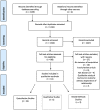The relationship between physician burnout and depression, anxiety, suicidality and substance abuse: A mixed methods systematic review
- PMID: 37064688
- PMCID: PMC10098100
- DOI: 10.3389/fpubh.2023.1133484
The relationship between physician burnout and depression, anxiety, suicidality and substance abuse: A mixed methods systematic review
Abstract
Introduction: The World Health Organization defines burnout as a problem associated with employment, a category distinct from psychological disorders such as depression, anxiety, suicidality and disorders of substance abuse. Evaluating the association between burnout as an occupational exposure and psychological morbidity may indicate that burnout can act as an occupational risk factor for mental ill-health. The systematic review explores this relationship in physicians due to the increased risk in this population and the implications for healthcare delivery.
Methods: A mixed methods systematic review of the literature was conducted across Medline, Cinahl Plus, PsycInfo, Web of Science and The Cochrane Library. Databases were systematically searched using keywords relating to physician burnout and depression, anxiety, suicidality and substance abuse. Identified articles were screened for eligibility by two independent researchers. Data extraction was performed and studies assessed for risk of bias. Quantitative and qualitative results were integrated using a convergent segregated approach and results portrayed as a narrative synthesis.
Results: Sixty-one articles were included in the review. There was notable heterogeneity in the measurement and criteria used to define burnout limiting the assimilation of results. Despite this, all studies that measured the association between depression and burnout reported a significant association. Studies that reported association between burnout and anxiety were similarly uniformly consistent. Most studies that reported the association between burnout and suicidality indicated that a significant association exists however difficulty in measurement of suicidality may have influenced variability of results. The reported association between substance abuse and burnout was more variable, suggesting that any association is likely to be weak or influenced by other variables. Qualitative studies described the manifestations of chronic workplace stress as well as perceived links with psychological morbidity. These included lack of time for work-life balance, the contribution of professional relationships and a culture of invulnerability that exists among physicians.
Conclusion: The systematic review cannot conclude causality but suggests that physician burnout is associated with depression, anxiety and suicidality. Qualitative data provides insight into the nature of this association. The review indicates the need for longitudinal research and provides considerations for intervention strategies to prevent the development and progression of burnout.
Systematic review registration: https://www.crd.york.ac.uk/prospero/display_record.php?ID=CRD42020172938, identifier: CRD42020172938.
Keywords: anxiety; burnout—professional; depression; substance misuse; suicidal ideation (SI); systematic review.
Copyright © 2023 Ryan, Hore, Power and Jackson.
Conflict of interest statement
The authors declare that the research was conducted in the absence of any commercial or financial relationships that could be construed as a potential conflicts of interest.
Figures
References
-
- Maslach C, Jackson SE. Burned-out cops and their families. Psychol Today. (1979) 12:59–62.
-
- Freudenberger HJ. Staff burn-out. J Soc Issues. (1974) 30:159–65. 10.1111/j.1540-4560.1974.tb00706.x - DOI
-
- The World Health Organisation . WHO | International Classification of Diseases, 11th Revision (ICD-11). Internation Classification of Diseases 11th Revision (ICD-11) (2019).



